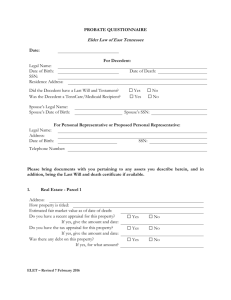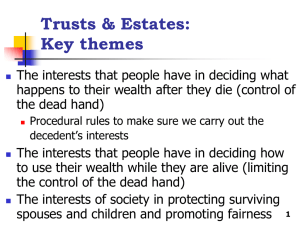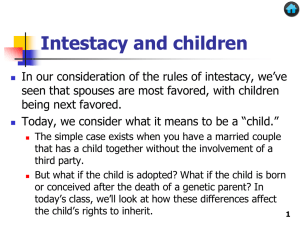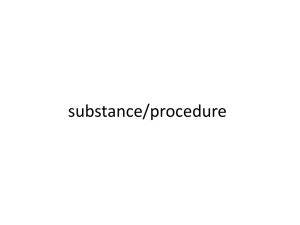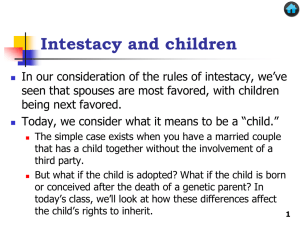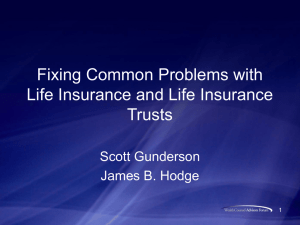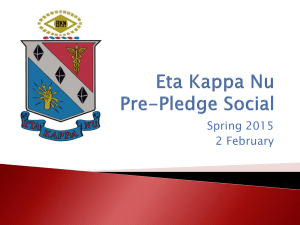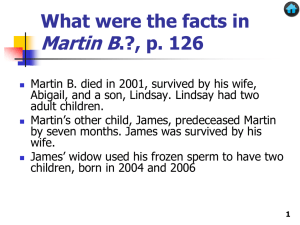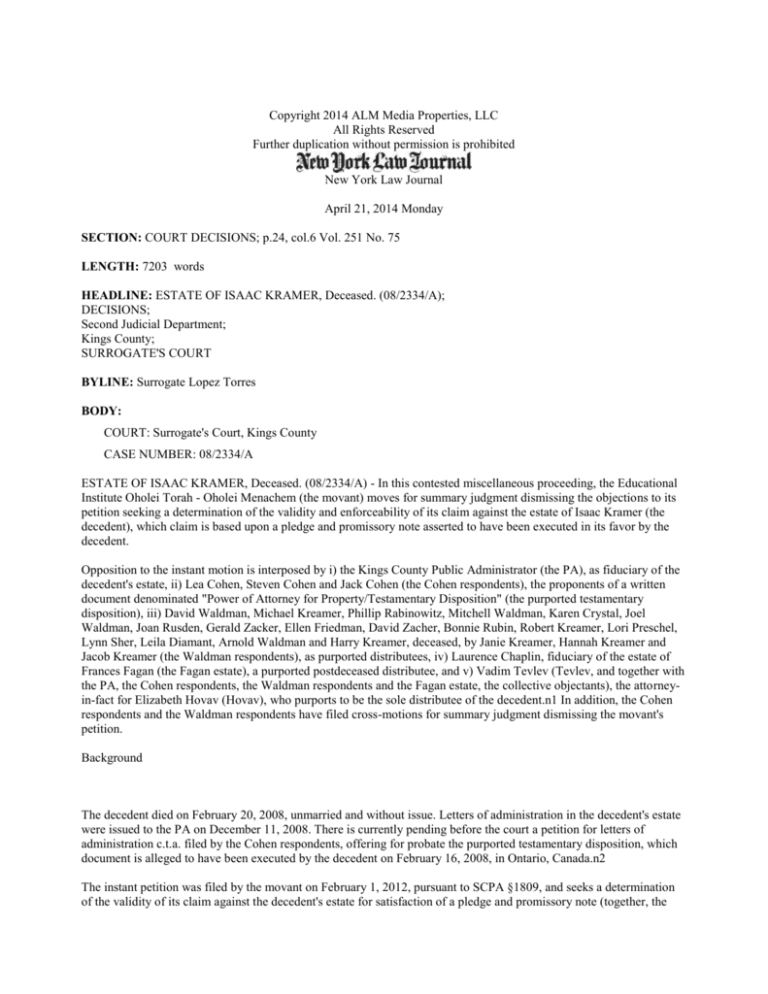
Copyright 2014 ALM Media Properties, LLC
All Rights Reserved
Further duplication without permission is prohibited
New York Law Journal
April 21, 2014 Monday
SECTION: COURT DECISIONS; p.24, col.6 Vol. 251 No. 75
LENGTH: 7203 words
HEADLINE: ESTATE OF ISAAC KRAMER, Deceased. (08/2334/A);
DECISIONS;
Second Judicial Department;
Kings County;
SURROGATE'S COURT
BYLINE: Surrogate Lopez Torres
BODY:
COURT: Surrogate's Court, Kings County
CASE NUMBER: 08/2334/A
ESTATE OF ISAAC KRAMER, Deceased. (08/2334/A) - In this contested miscellaneous proceeding, the Educational
Institute Oholei Torah - Oholei Menachem (the movant) moves for summary judgment dismissing the objections to its
petition seeking a determination of the validity and enforceability of its claim against the estate of Isaac Kramer (the
decedent), which claim is based upon a pledge and promissory note asserted to have been executed in its favor by the
decedent.
Opposition to the instant motion is interposed by i) the Kings County Public Administrator (the PA), as fiduciary of the
decedent's estate, ii) Lea Cohen, Steven Cohen and Jack Cohen (the Cohen respondents), the proponents of a written
document denominated "Power of Attorney for Property/Testamentary Disposition" (the purported testamentary
disposition), iii) David Waldman, Michael Kreamer, Phillip Rabinowitz, Mitchell Waldman, Karen Crystal, Joel
Waldman, Joan Rusden, Gerald Zacker, Ellen Friedman, David Zacher, Bonnie Rubin, Robert Kreamer, Lori Preschel,
Lynn Sher, Leila Diamant, Arnold Waldman and Harry Kreamer, deceased, by Janie Kreamer, Hannah Kreamer and
Jacob Kreamer (the Waldman respondents), as purported distributees, iv) Laurence Chaplin, fiduciary of the estate of
Frances Fagan (the Fagan estate), a purported postdeceased distributee, and v) Vadim Tevlev (Tevlev, and together with
the PA, the Cohen respondents, the Waldman respondents and the Fagan estate, the collective objectants), the attorneyin-fact for Elizabeth Hovav (Hovav), who purports to be the sole distributee of the decedent.n1 In addition, the Cohen
respondents and the Waldman respondents have filed cross-motions for summary judgment dismissing the movant's
petition.
Background
The decedent died on February 20, 2008, unmarried and without issue. Letters of administration in the decedent's estate
were issued to the PA on December 11, 2008. There is currently pending before the court a petition for letters of
administration c.t.a. filed by the Cohen respondents, offering for probate the purported testamentary disposition, which
document is alleged to have been executed by the decedent on February 16, 2008, in Ontario, Canada.n2
The instant petition was filed by the movant on February 1, 2012, pursuant to SCPA §1809, and seeks a determination
of the validity of its claim against the decedent's estate for satisfaction of a pledge and promissory note (together, the
subscription) in the amount of $1,800,000.00. The movant asserts that the decedent executed the pledge and the
promissory note on August 14, 2006, pursuant to which he agreed to donate $1,800,000.00 in support of the movant's
plans to construct a "ritualarium," or mikveh, with two underground pools, showers and changing rooms (the building
project). The promissory note reflects a maturity date of one year from the date of execution, or August 14, 2007.
Verified objections to the petition were filed by the each of the collective objectants, pursuant to which they assert a
variety of affirmative defenses. All assert that the decedent's signature on the pledge is not genuine, while the PA also
asserts that the pledge was not duly executed. All assert that the pledge fails for lack of consideration, while the
Waldman and Cohen respondents also assert that the pledge was unfulfilled or lapsed upon the decedent's death. The
PA, the Waldman respondents and the Cohen respondents assert that the movant's claim is barred by the doctrine of
laches and unclean hands, while the Waldman respondents also assert that the claim is barred by the statute of
limitations. The Waldman and Cohen respondents further assert that the movant's claim is barred on the grounds of
fraud or fraudulent inducement. Finally, the Fagan estate, Tevlev and the Waldman respondents assert that the decedent
lacked capacity to make the pledge at the time of its execution.
The movant now seeks summary judgment dismissing these objections. The movant asserts that the subscription is an
enforceable charitable pledge freely made, that the decedent possessed capacity to execute the subscription and that its
claim therefor was timely filed. The movant further asserts that the collective objectants proffer no evidence in support
of their allegations of lack of due execution, fraud, forgery or lack of capacity, or the doctrines of laches or unclean
hands.
The movant relies for support of the instant motion on copies of, inter alia, i) the affidavit of Rabbi Joseph Rosenfeld
(Rabbi Rosenfeld), the movant's president, ii) the deposition of Rabbi Nosson Blumes (Rabbi Blumes), the movant's
director of development, iii) the deposition of Rabbi Menachem Mendel Lerman (Rabbi Lerman), the director of the
movant's building committee, iv) the federal estate tax return for the decedent's estate, v) a print-out of the decedent's
donations to the movant, vii) a last will and testament, dated November 5, 1985, executed by the decedent and revoked
on July 1, 1996 (the prior will), viii) articles about and photographs of the decedent collected from the movant's annual
dinner journals, including from the 2000 annual dinner at which the decedent was honored as the movant's "Man of the
Year" and from the 2008 annual dinner at which the decedent was memorialized, ix) advertisements purchased by the
decedent in honor of his family members and published in the movant's annual dinner journals, xi) various plans,
schematics and bids or proposals for the building project, and xii) exemplars of the decedent's handwriting.
Each of the collective objectants opposes the instant motion. Both the Waldman and Cohen respondents cross-move for
summary judgment, asserting that the movant's claim must be denied in light of its failure to demonstrate acceptance of
the subscription by taking action in reliance thereon. The Waldman and Cohen respondents further assert that the
movant has significantly altered the scope and location of the building project, resulting in frustration of the purpose of
the subscription. In addition, the Cohen respondents assert that the handwriting expert engaged by the PA "was unable
to confirm with any certainty" that the signatures on the subscription documents were in fact those of the decedent.
Finally, the Fagan estate asserts that an issue of fact exists with respect to the decedent's capacity at the time of
execution of the subscription.
Summary Judgment
The general proposition that summary judgment is a drastic remedy and is to be granted sparingly is oftstated. Wanger
v. Zeh, 45 Misc.2d 93 (Sup. Ct. Albany County 1965), aff'd, 26 A.D.2d 729 (3d Dep't 1966). The court's function on a
motion for summary judgment is issue-finding, rather than issue-determination. See, e.g., Columbus Trust Co. v.
Campolo, 110 A.D.2d 616 (2d Dep't 1985); In re Bank of New York, 269 A.D.2d 112 (1st Dep't 2000). The proponent
must make a prima facie showing of entitlement to judgment as a matter of law, tendering sufficient evidence to
demonstrate the absence of any material issues of fact. Alvarez v. Prospect Hosp., 68 N.Y.2d 320 (1986). Upon review
of a motion for summary judgment, the evidence proffered in support thereof must be scrutinized carefully in the light
most favorable to the parties opposing such motion. Marine Midland Bank, N.A., v. Dino and Artie's Automatic
Transmission, 168 A.D.2d 610 (2d Dept 19990). Failure to make a prima facie showing requires denial of the motion,
regardless of the sufficiency of the opposing papers. Winegrad v. New York Univ. Med. Ctr., 64 N.Y.2d 851, 853 (1985).
Once this showing has been made, the burden shifts to the party opposing the motion to produce evidentiary proof in
admissible form sufficient to establish the existence of material issues of fact which require a trial of the action.
Zuckerman v. City of New York, 29 N.Y.2d 557 (1980). "[M]ere conclusions, expressions of hope or unsubstantiated
allegations or assertions fail to raise a triable issue of fact." Id. at 562.
As a threshold issue, the PA asserts that the motion for summary judgment must be dismissed on the grounds of
procedural defect due to the movant's failure to attach copies of the underlying pleadings. "While CPLR §3212 (b)
requires that motions for summary judgment be supported by, inter alia, a copy of the pleadings, CPLR §2001 permits a
court, '[a]t any stage of an action,' to disregard a partys mistake, omission, defect, or irregularity if a substantial right of
a party is not prejudiced." Avalon Gardens Rehabilitation & Health Care Ctr., LLC, v. Morsello, 97 A.D.3d 611, 612
(2d Dep't 2012). The court notes that neither the Waldman respondents nor the Cohen respondents attached copies of
the underlying pleadings to their respective cross-motions, and that the movant attached the relevant pleadings to its
reply papers in support of its motion and in opposition to the cross-motions. Accordingly, the court finds that, in the
absence of prejudice to any party and in the interests of judicial economy, dismissal of the instant motion and crossmotions pursuant to CPLR §3212 (b) is not warranted.
Discussion
The following facts are undisputed. The decedent was a long-time resident of the Crown Heights community, and for
many years was an active member of the Brooklyn Jewish Center, a Conservative synagogue located at 667 Eastern
Parkway. Over the years as membership in the Brooklyn Jewish Center declined, the movant, a yeshiva affiliated with
the Chabad - Lubavitch movement, first leased and then ultimately purchased the Brooklyn Jewish Center's property.
The decedent maintained a relationship with the movant, and from 1989 through 2006 made periodic donations totaling
$42,153.06.n3 The decedent was honored as the movant's "Man of the Year" at its annual dinner in 2000, and was
memorialized at its annual dinner in 2008. The decedent frequently purchased advertisements in the movant's annual
dinner journals, by which he honored the memory of his parents and family. In addition, the decedent included in the
prior will a bequest to the movant in the amount of $25,000.00, intended "to fund a suitable memorial or scholarship
fund in memory of [his] parents, Max and Anna Kramer."
The movant asserts that the decedent had attended a "groundbreaking" ceremony and dinner inaugurating the campaign
for the building project in June 2006. The movant asserts that, two months later, on August 14, 2006, the decedent
requested and was afforded a meeting with Rabbi Rosenfeld, his neighbor and the movant's president. Also present at
that meeting, at the behest of Rabbi Rosenfeld, were Rabbi Blumes and Rabbi Lerman. The movant asserts that at the
meeting the decedent "initiated a discussion" regarding plans for the building project and his desire to provide support
therefor. The movant asserts that the decedent reviewed building plans brought by Rabbi Lerman and stated his
intention to pledge $1,800,000.00 in support of the building project, on the condition that a wing of the new building be
dedicated in memory of his family. The movant asserts that Rabbi Rosenfeld filled out both the pledge form and the
promissory note, and that the decedent affixed his signature to each. The movant asserts that the decedent suggested that
the promissory note be payable within one year, and that he advised Rabbi Rosenfeld of the number of his bank account
at JPMorgan Chase Bank, N.A., which was noted thereon.n4 The movant asserts that the subscription documents were
then kept on file by Rabbi Blumes in his office. The movant asserts that illness during the summer of 2007 prevented
Rabbi Rosenfeld from seeking satisfaction of the subscription upon its maturity, and that after his recovery Rabbi
Rosenfeld declined to seek satisfaction due to the decedent's own illness.
Notwithstanding its failure to seek to collect the subscription during the decedent's lifetime, the movant asserts that the
subscription is a charitable pledge enforceable against the decedent's estate. The movant asserts that the subscription
was freely made by the decedent who had the requisite capacity to make such a gift at the time thereof. The movant
asserts that the decedent was a longtime and widely-recognized supporter of its work, and that it has proceeded with the
building project, including solicitation of additional donations and the relocation and expansion of the building project,
in reliance on fulfillment of the decedent's subscription. The movant further asserts that its claim, served on the PA on
July 13, 2011, was timely made, and is barred neither by the statute of limitations nor by the doctrine of laches.
The instant motion for summary judgment seeks in part to dismiss those objections interposed by the PA, the Waldman
respondents and the Cohen respondents which are grounded on lack of due execution and the affirmative defenses of
fraud, fraudulent inducement, the statute of limitations, the doctrine of laches, and the doctrine of unclean hands. The
court notes that none of the responsive papers submitted by the PA, the Waldman respondents or the Cohen respondents
proffer any support for, or indeed even address, these six objections. Accordingly, the court deems these objections to
the movant's petition to have been abandoned, and the motion for summary judgment dismissing said objections, to wit,
those grounded on lack of due execution, fraud, fraudulent inducement, the statute of limitations, the doctrine of laches,
and the doctrine of unclean hands, is hereby granted.
The instant motion also seeks to dismiss the objection interposed by the Fagan estate, Tevlev and the Waldman
respondents which alleges that the decedent lacked capacity to execute the subscription. The Fagan estate is the only
party to address this objection in its opposition. The Fagan estate relies for support on, inter alia, copies of i) the
deposition of its counsel, Seth Rubenstein, Esq. (Rubenstein), and ii) a letter from Rabbi Chaim Fogelman to
Rubenstein (the Fogelman letter).
It is well-established that "[a] party's competence is presumed and the party asserting incapacity bears the burden of
proving incompetence." Crawn v. Sayah, 31 A.D.3d 367 (2d Dep't 2006) (quoting Feiden v. Feiden, 151 A.D.2d 889,
890 [3d Dep't 1989]). See also 400 West 59th Street Partners, LLC v. Edwards, 28 Misc. 3d 93 (N.Y. Sup. Ct. App.
Term 2010). Any inquiry into the decedent's capacity must focus on "whether the [decedent] was capable of
comprehending and understanding the nature of the transaction at issue." Smith v. Comas, 173 A.D.2d 535 (2d Dep't
1991). Even upon demonstration that a party may have been afflicted with, for instance, dementia, the party asserting
incompetence must further show that, "because of the affliction, the individual was incompetent at the time of the
challenged transaction." Gala v. Magarinos, 245 A.D.2d 336, 337 (2d Dep't 1997).
The Fagan estate proffers the deposition testimony of Rubenstein, in which he recounts a meeting at his office, on
November 4, 2009, attended by Rabbi Rosenfeld, together with an attorney and two other rabbis.n5 Rubenstein testified
that Rosenfeld relayed to him an expectation that the movant would be a beneficiary of the decedent's estate under the
prior will, and that when advised of the existence of the purported testamentary disposition and impending probate
contest, the rabbis expressed their belief that the decedent lacked capacity to execute the purported testamentary
disposition. In his deposition, Rubenstein asserts his impression that the rabbis, including Rabbi Rosenfeld, were
prepared to offer their testimony regarding the decedent's lack of capacity in exchange for satisfaction of their legacy
under the prior will.
The Fagan estate also proffers the Fogelman letter, which purports to offer evidence of the decedent's lack of capacity
based on Rabbi Fogelman's personal interactions with the decedent. The Fogelman letter describes examples of the
decedent's confused behavior, including, inter alia, the decedent's belief that his caregivers were stealing his belongings,
his attempts to make purchases with Russian rubles, his tendency to forget to eat, and his habit of writing checks on
long-dormant accounts or of interrupting during conversations to ask, "What are we talking about?" The Fogelman letter
neglects to identify the time period during which these purported mental lapses occurred, making only a single reference
to "the last few months he was with us in New York (before he was taken to Canada)" in connection with the decedent's
tendency to interrupt conversations.
The Fagan estate proffers no independent or extrinsic of the decedent's capacity at the time the subscription was
executed. The Fagan estate challenges the decedent's mental state based on its counsel's extrapolations of likely
testimony by the movant's representatives, buttressed by a general account of the decedent's confused behavior during a
unspecified period of time before his death. Such musings are insufficient to raise a triable issue of fact on the issue of
mental capacity. There are proffered no physicians' reports nor any independent evaluation of the decedent's mental
status, nor is there proffered evidence regarding any medications or treatments prescribed to the decedent. The record is
bereft of any independent evidence of the decedent's mental status on August 14, 2006, the date on which the
subscription was executed. Accordingly, the Fagan estate having failed to proffer evidence sufficient to raise a triable
issue of fact regarding the decedent's mental capacity at the time of execution of the subscription, the motion for
summary judgment dismissing the objection grounded on lack of capacity is hereby granted.
The instant motion also seeks summary judgment dismissing the objection interposed by the collective objectants that
the decedent's signature on the subscription agreement is not genuine. The Cohen respondents are the only parties to
address opposition to the motion to dismiss this objection. While notarization or other authentication of a signature
"raises a presumption that the signature is genuine" (Seaboard Sur. Co. v. Earthline Corp., 262 A.D.2d 253 [1st Dep't
1999]), the decedent's signature is purported to have been affixed in the presence of three representatives of the movant
and was not authenticated. See Dart Associates v. Rosal Meat Market, Inc., 39 A.D.2d 564 (2d Dep't 1972).
Nonetheless, both the movant and the Cohen respondents rely on a handwriting report, dated June 14, 2013 (the report),
of John Paul Osborn (the handwriting analyst), a forensic document examiner retained by the PA. Unsurprisingly, the
movant asserts that the findings of the handwriting analyst support a determination that the decedent's signatures on the
subscription are genuine, while the Cohen respondents urge that such findings raise a triable issue of fact with respect to
the possibility of forgery.
The report relied upon by both parties sets forth the results of a comparison of the purported signatures of the decedent
on both the pledge and the promissory note against copies of sixteen documents bearing known genuine signatures of
the decedent. The report enumerates several "limiting factors," including "the lack of any original (writing ink on paper)
known genuine specimen signatures" and the paucity of known genuine signatures submitted for 2006, the year in
which the questioned signatures are dated. The report, under the paragraph titled "Findings," states that "[t]here are
indications (emphasis in original), in the opinion of the [handwriting expert], that both of the two questioned
signatures... are genuine." The term "indications" is alternately defined in the report as "evidence to suggest," and is
characterized as "a very weak opinion." The Cohen respondents assert that the "very weak opinion" of the handwriting
analyst is sufficient to raise a triable issue of fact regarding the genuineness of the decedent's handwriting. Nonetheless,
comprehensive review of the extensive comments of the analyst reveals a less equivocal finding. The analyst reports
that
[t]here is no doubt that neither of the questioned signatures are the natural writing of an individual other than [the
decedent]. A casual comparison of each questioned signature and the known specimens will adequately establish that
the questioned Promissory Note and Pledge Card signatures are, at a minimum, pictorially similar to the known
specimens.... Therefore, it is reasonable to initially conclude that each questioned signature is either genuine, or an
attempt by someone to simulate the writing characteristics found in [the decedent's] genuine signature....One will note
[referring to a comparison chart] that virtually all of the variations appearing within each of the two questioned
signatures are adequately represented in at least one of the known genuine specimen signatures...This lack of significant
or fundamental differences in form does lend credibility to the two signatures, and the presence of speed of execution on
some complex portions of both signatures provide a combination of evidence justifying the findings rendered in this
report.
The handwriting analyst goes on to state that the failure to submit original known genuine signatures for comparison
contributes to his "weak" opinion. Even viewing the proffered report in the light most favorable to the Cohen
respondents, the court finds that no triable issue of fact is raised regarding the genuineness of the decedent's signature
on the pledge or the promissory note. The report indicates that, at the very least, the signatures are not the natural
signatures of a third party, and that the genuine signatures offered for comparison are insufficient to support more than a
"weak" finding of authenticity. Nonetheless, the report notes that a comparison of characteristics of the genuine
signatures to those questions lends "credibility" to the questioned signatures. It is notable that the report does not
employ standard terminology to indicate the likelihood of forgery, such as "no conclusion," "indications did not,"
"probably did not" or "strong probability did not." Accordingly, the motion to dismiss the objection interposed on the
grounds of forgery is hereby granted.
The remaining objection, interposed by each of the collective objectants, is grounded on the assertion that the
subscription is unenforceable against the decedent's estate for failure of consideration. It is well-established that "as a
matter of public policy, pledge agreements calculated to foster eleemosynary enterprises are enforceable." Woodmere
Academy v. Steinberg, 41 N.Y. 2d 746, 749 (1977). In the instant matter, the decedent executed a pre-printed pledge card
provided by the movant's representatives, which included the following language: "I/we hereby pledge, and/or enclose
the sum of $_______ to Oholei Torah, as my participation for the furtherance of Jewish Education and Survival." The
pledge also contains a section designated "Notes," in which is written "Dedicating a wing in a building." Rabbi
Rosenfeld acknowledges that he filled out the subscription amount of $1,800,000.00, as well as the notation of the
dedication, and that the decedent signed the subscription. The subscription thus was clearly intended by the decedent to
support a particular project proposed to be undertaken by the movant, rather than as a donation in furtherance of the
movant's general educational and religious work. Generally, the rationale underpinning enforcement of a pledge in
furtherance of a charitable campaign is based on the theory of unilateral contract, as a pledge "is not a contract, but an
offer to contract, which, when acted upon by incurring liability, becomes a binding obligation." I. & I. Holding
Coporation v. Gainsburg, 276 N.Y. 427, 433 (1938). It has been the
noted policy of the courts to sustain the validity of subscription agreements whenever a counter promise of the donee
can be deduced from the actions of the parties or it can be demonstrated that any legal detriment has been sustained by
the promisee in reliance upon the promised gift (emphasis added).
In re Lord's Will, 175 Misc. 921, 927 (Sur. Ct. Kings County 1941). Thus, the question before the court is whether the
movant has demonstrated that the subscription in furtherance of the building project was accepted by the movant by
undertaking actions in reliance thereon.
The movant asserts that, in reliance on the decedent's subscription, it has paid for architectural and mechanical plans for
the building project, has paid for soil tests for the proposed site, and has solicited additional donations on the strength of
the decedent's subscription. The movant further asserts that, upon completion of the project, a "wing" or floor of the
new building will be dedicated in honor of the decedent's family. The movant relies for support of its motion primarily
on the affidavit of Rabbi Rosenfeld, the depositions of Rabbi Blumes and Rabbi Lerman, a copy of the decedent's donor
history, and copies of various plans, drawings, bids, proposals and correspondence relating to the building project.
In opposition, the PA, the Cohen respondents and the Waldman respondents assert that the movant has failed to
demonstrate the requisite reliance, as no proof of substantial activity or meaningful progress on the building project has
been proffered. They also assert that the movant has failed to offer proof of reliance on the subscription for solicitation
of additional pledges for the building project. The PA, the Cohen respondents and the Waldman respondents rely for
support of their opposition on the same evidence proffered by the movant, as well as on the deposition testimony of
Rabbi Rosenfeld and on a copy of an invoice, dated June 10, 2010, for soil tests performed in connection with the
building project.
It is undisputed that the building project has not been completed; indeed, construction has not even begun. In his
affidavit in support of the movant's motion, Rabbi Rosenfeld asserts that the original plans for the building project were
formulated in 2004 and 2005, and that in 2006 or 2007 the movant obtained proposals from builders, and mechanical/
structural engineering firms; however, upon inquiry as to the status of the building project at his deposition, Rabbi
Rosenfeld testified variously that "it has not been built" and that it "has not been constructed yet." When asked whether
even the original ground floor mikveh had been built, Rabbi Rosenfeld testified, "Never." Nonetheless, he asserts that
the scope of the building project has been expanded, and that the movant has obtained bids and plans therefor. Rabbi
Rosenfeld also asserts that the movant has spent "between $15,000 and $20,000" for soil testing at the proposed site and
has paid "a lot of money" towards the building project. In his deposition testimony, Rabbi Rosenfeld also asserts that the
movant has "engaged an architect" and "pursued" the project, but he could not identify the current engineer for the
building project, and reaffirmed that construction has not yet commenced. He estimated that the building project, which
has evolved from a four-story to an eight-story building, will soon begin and asserts that with "God's help around three
to four years from now you'll see it."
With respect to funding of the building project, Rabbi Rosenfeld testified at his deposition that he and five other
members of the movant's community were the primary fundraisers for the building project. He was unable to recall the
amount of funds raised in 2006 in support of the buiding project, asserting that Rabbi Blumes maintained such records.
He testified that while he anticipated having to borrow funds in order to complete the building project, he had never
utilized the subscription in support of any loan request for construction purposes.
Rabbi Blumes, the movant's director of development for seventeen years, testified that his duties include working with
potential and current donors, and that he maintains a "very specific list of who the donors are, what they have donated,
what was donated for, different pledges." While he acknowledged that he was "somewhat familiar" with the decedent's
subscription, he repeatedly testified that he is tasked with following up on only those pledges or subscriptions which
result from his personal efforts. He testified that the subscription documents were kept on file in his office, but that he
never spoke with the decedent about his pledge subsequent to August 14, 2006.
Rabbi Blumes confirms that the original plans for the building project commenced in "probably in 2005," but testified,
when queried about the status thereof, "it never came to fruition because there wasn't enough money." Although he
could not recall with specificity the number of pledges besides the decedent's which were received in furtherance of the
building project, Rabbi Blumes asserted his belief that the movant had received "30 or 40" pledges in excess of $10,000
each. He testified that the movant is still soliciting donations in support of the building project, and that he does not
know how much money has been expended by the movant on the building project to date. He further testified that he
generated reports of pledges received and their status as paid or unpaid "extremely rarely," and he could not confirm
that all pledges received by Rabbi Rosenfeld or the other fundraisers were actually entered into the movant's database of
contributions. Rabbi Blumes testified that he has not prepared any report reflecting funds raised or pledges outstanding
in connection with the building project, stating he had done so "maybe years ago but not for sure recently."
Rabbi Lerman, the director of the movant's building committee, testified that he has held this position since the mid1990's, and that the committee consists of parents with relevant business and construction backgrounds. He testified that
he acts as liaison between the committee and contractors and architects employed by the movant. He testified that plans
for the building project, as originally conceived, were commenced in 2005 and finalized in October 2006. He testified
that the original projected cost of the building project was approximately $2,000,000 per floor, and that construction
was intended to start with the ground floor mikveh at a cost of approximately $2,500,000.00, proceeding upward one
floor at a time as funds became available. He testified that he received four bids on the building project in January 2007,
and that the building committee selected a builder who required a deposit of between 15 percent and 20 percent of the
projected cost. He testified that in the spring of 2007 he realized that construction was not going to proceed because
"Rabbi Rosenfeld did not give [the builder] that." Indeed, Rabbi Lerman testified that Rabbi Rosenfeld advised him that
the movant had insufficient funds to proceed with the project, and further testified that he did not inquire of Rabbi
Rosenfeld whether the decedent's subscription might be applied in support of a deposit.
When queried, Rabbi Lerman confirmed that the decedent's pledge was intended to support the construction of a
building which does not yet exist. He confirmed that no construction on the building project, either as originally
conceived or in its expanded form, has commenced, stating that "actual construction, nothing was done." He testified
that the movant has over the years purchased a number of adjacent lots, and that the current plan is to demolish any
houses remaining thereon, making way for construction of the newly-envisioned eight-story building. He testified that
the movant has mechanical and architectural plans for this expanded project, and that it has expended funds on soil
testing. He further testified that the zoning and building permit processes are "almost finalized."
The evidence proffered by the movant in support of its motion also includes i) a letter dated July 19, 2006, from
structural engineers relating to redesign of the mikveh, ii) an invoice, dated November 3, 2006, for design revisions to
the plan for the mikveh, iii) two contractors' bids, dated December 13, 2006, and January 29, 2007, respectively, for
construction of a mikveh, iv) a list dated February 6, 2007, detailing four construction bids received, and v) architectural
drawings and renderings, some of which appear to be dated in 2004, and others which represent an eightstory building.
Both the movant and the collective respondents rely on identical case law in support of their opposing conclusions
regarding reliance. The case law cited in fact supports this court's finding that the movant has failed to satisfy its burden
of a prima facie demonstration of reliance on the decedent's subscription. In many of the cases cited by the parties, some
substantive progress had been accomplished towards the charitable purposes for which the pledges were received. See,
e.g., Cohoes Memorial Hospital v. Mossey, 25 A.D.2d 476 (3d Dep't 1966) (pledge in support of construction of new
hospital was enforceable as hospital was actually built); In re Lord's Will, supra (decedent's pledge in support of
college's plans for library was enforceable, as college had employed and paid architects for plans and construction was
underway); Liberty Maimonides Hospital v. Felberg, 4 Misc. 2d 291 (N.Y. Co. Ct. Sullivan County 1957) (enforcing a
charitable pledge for construction of new hospital, where claimant demonstrated, inter alia, that additional pledges were
raised and a construction loan had been obtained).
In some instances, charitable pledges have been enforced where partial payments were made. See, e.g., Allegheny
College v. National Chautauqua County Bank of Jamestown, 246 N.Y. 369 (1927) (pledge to college's endowment,
payable 30 days after death, enforceable where partial payment was made on account during decedent's lifetime, as
acceptance thereof created a bilateral contract between the parties); In re Kirby's Will, 39 Misc.2d 190 (Sur. Ct.
Westchester County 1967) (enforcing decedent's pledge to a church, where decedent made partial payment, church
established a budget in reliance thereon and "necessarily incurred other obligations"); In re Lipsky's Estate, 45 Misc. 2d
320 (Sur. Ct. New York County 1965) (enforcing a charitable pledge to the UJA where partial payment was made);
Matter of de Brabant's Estate, 197 Misc. 923 (Sur. Ct. New York County 1949) (enforcing decedent's charitable pledge
for construction of a chapel where partial payments were made and decedent re-affirmed her charitable intentions).
Finally, in a number of cases charitable pledges have been found enforceable where the facts demonstrated actions in
reliance by the donees as well as partial payments by the donors. See, e.g., Woodmere Academy, supra (school entitled
to remaining amount pledged for school library construction where partial payment had been made and library was
completed); Paul and Irene Bogoni Foundation v. St. Bonaventure University, 78 A.D.3d 616 (1st Dep't 2010)
(university entitled to recover remaining amount of pledge toward library expansion project where additional pledges
were secured in reliance thereon and library was actually constructed); In re Metz' Estate, 262 A.D. 508 (1st Dep't 1941)
(charitable subscription by decedent for continuation of construction of synagogue deemed accepted where temple
resumed construction, incurred obligations and first installment of pledge had been paid); In re Field's Estate, 11 Misc.
2d 427 (Sur. Ct. Suffolk County 1958) (two oral charitable pledges held enforceable where, in one case, donee had
incurred financial obligations in reliance thereon, and in the second case, construction was partially completed and
decedent had made partial performance of his pledge).
Despite the movant's assertion that it has been "actively engaged" in pursuit of the building project, the evidence
submitted in support of reliance is susceptible of no such conclusion. The proffered evidence, taken as a whole, fails to
constitute a prima facie demonstration of the movant's reliance on the decedent's subscription. Without addressing
whether the expansion of the scope of the building project operates to frustrate its purpose, the evidence does not
demonstrate any meaningful progress or substantive action on the building project, in either its original or most recent
incarnation. Each of Rabbi Rosenfeld, Rabbi Blumes and Rabbi Lerman acknowledges, repeatedly, that no construction
of any sort has been commenced. The movant's representatives offer no specific date upon which construction is likely
to commence nor any realistic time frame within which the building project is anticipated to be completed. Rather, it is
readily apparent that the consummation of building project is a hoped-for occurrence, an expectation of uncertain
fruition.
The limited extrinsic evidence proffered in support of the movant's assertion that the building project is currently
progressing consists only of a few documents which reflect simple proposals or plans long-superseded. Notably, the
movant's representatives asserts that "a lot of money" has been paid in furtherance of the building project, yet no proof
whatsoever of payment of any construction-related expense is submitted in support of the movant's claim. In fact, the
only expenses of construction for which proof is offered are invoices alone, rather than receipts for payment, for de
minimis sums incurred in 2006 in re-designing the mikveh. Further, the movant's representatives assert that "between
$15, 000 and $20,000" has been spent on soil tests for the proposed site, yet again no proof of such payment is
proffered. Instead, the movant offers only a single invoice for $13,575.00, rather than a receipt for payment thereof, for
soil testing in 2010. Rabbi Rosenfeld asserts that an architect has been engaged, yet no contract or letter of engagement
with any architect, design professional, construction or mechanical engineer or contractor, nor proof of any payment
thereto, has been proffered. The representatives of the movant assert that receipt of zoning and building permits is
imminent, yet no extrinsic documentation of applications therefor, or communications related thereto, are proffered in
support of these assertions. The movant's representatives assert that adjacent parcels of land have been purchased and
demolition has proceeded in anticipation of expansion, yet no proof of such purchases, of permit applications, of zoning
applications, indeed of any plans relating to the use of the parcels, is proffered.
Furthermore, the representatives of the movant assert that they have secured "30 or 40" pledges "in excess of $10,000"
each in furtherance of the building project, yet no independent evidence of receipt or fulfillment of such pledges is
proffered. The movant's representatives assert that they have relied on the decedent's subscription, one of tremendous
significance, in soliciting additional pledges for the building project, yet no building campaign literature or other
communication is proffered to support their claim that the decedent's subscription was relied upon to attract any other
pledges specifically dedicated to the building project.
Despite the widely-recognized public policy favoring enforcement of charitable pledges, consideration must actually be
demonstrated by proof of meaningful and substantive actions in reliance thereon. The facts of the instant case, and the
negligible proof submitted, necessitate a finding that the movant has neither commenced construction, formally engaged
any design, engineering or building professionals to commence construction, nor incurred any obligations, legal,
financial or contractual, with respect to the building project. Accordingly, the motion to dismiss the objection to the
petition for a determination of the validity and enforceability of the decedent's pledge, dated August 14, 2006, in the
amount of $1,800,000.00 and in favor of the movant, is denied, and the cross-motions by the Cohen respondents and the
Waldman respondents to dismiss the said petition is hereby granted.
This constitutes the decision and order of the court.
Date: April 15, 2014
[note 1] The identity of the decedent's distributees remains undetermined; notwithstanding this fact, the
Cohen respondents, the Waldman respondents, the Fagan estate and Tevlev each moved for leave to
intervene in the instant proceeding, which motions were granted by order, dated August 6, 2012, of
Acting Surrogate Cutrona. In addition to being a proponent of the purported testamentary disposition,
Lea Cohen purports to be a first cousin, once removed, of the decedent. The Waldman respondents also
purport to be the decedent's first cousins, once removed. Tevlev asserts that Hovav is the decedent's niece
and sole distributee, while the fiduciary of the Fagan estate asserts that Fagan was a first cousin of the
decedent, and is his sole distributee.
[note 2] Pursuant thereto, the decedent revoked all prior powers of attorney and testamentary
dispositions, and directed that Lea Cohen shall receive certain real property owned by the decedent and
located in Brooklyn, New York, together with one-half of his remaining assets. In addition, the purported
testamentary disposition provides that Lea Cohen shall not be precluded from claiming her intestate
share of the remaining half of the decedent's assets. The petition for letters of administration c.t.a.
indicates that the decedent left an estate valued at approximately $16,000,000.00, and states that he was
survived by one "alleged" first cousin (Francis Fagan), now deceased, and twenty-two first cousins onceremoved. Objections to the probate of the purported testamentary instrument have been filed by the PA,
as well as by the Waldman respondents, Tevlev and the Fagan estate.
[note 3] The decedent made six donations of modest amounts, less $200.00 each, during the years 1989
through 1996. The decedent's largest single donation, in the amount of $11,894.66, was made in 2000
when he was honored by the movant as its "Man of the Year."
[note 4] Although no evidence has been proffered, the collective objectants assert that the account
number written on the promissory note does not correlate to any account held by the decedent.
[note 5] Rubenstein and with his associate, Leo Beitner, Esq. (Beitner) were deposed in this matter due to
the assertions of Rabbi Rosenfeld that, as he departed the November 4, 2009, meeting, he met informally
with Beitner, that he advised Beitner of the existence of the subscription and the movant's intention to
seek fulfillment thereof, and that Beitner advised Rosenfeld to refrain from serving a notice of the
movant's claim until resolution of the contested probate. Beitner testified that his conversation with
Rosenfeld was purely casual and did not include any discussion, or in fact revelation, of the movant's
claim. Rubenstein testified also that Beitner made no mention to him of any claim against the estate by
the movant.
LOAD-DATE: April 21, 2014
Interwoven\3702010.1

